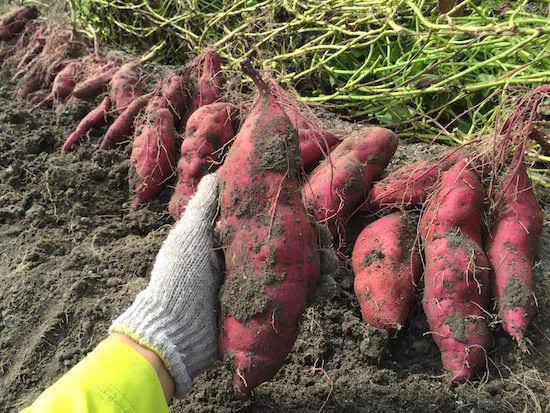November 28, 2025 | 04:18 GMT +7
November 28, 2025 | 04:18 GMT +7
Hotline: 0913.378.918
November 28, 2025 | 04:18 GMT +7
Hotline: 0913.378.918

27,000 tons of purple sweet potatoes in Vinh Long are in need of consumption support. Photo: TL.
According to the Department of Domestic Market (Ministry of Industry and Trade), due to the impact of the Covid-19 epidemic, Japanese purple sweet potatoes in Binh Tan district, Vinh Long province are experiencing backlog, prices have dropped, facing many difficulties in terms of market, really in need of businesses and distributors joining hand to create connection and improve consumption.
In order to promptly support the consumption of sweet potatoes to reduce losses for farmers, the Department of Domestic Market is coordinating with the Department of Industry and Trade of Vinh Long province to deploy solutions to promote the consumption of this item. At the same time, the Department of Domestic Market has also contacted distribution systems across the country to assist farmers.
Japanese purple sweet potato is a local key agricultural product for export to China, Japan and some other markets. However, according to the Department of Industry and Trade of Vinh Long province, at the moment, the Covid-19 epidemic situation is still developing complicatedly, so the consumption of agricultural products is greatly affected, including Japanese purple sweet potatoes in Binh Tan district, Vinh Long province.
As of August 20th, 2021, the area of sweet potatoes in the fields has about 2,820 ha left, in particular, the area of sweet potatoes coming to harvest time is about 900 ha, with an estimated output of about 27,000 tons. However, it’s because of the influence of the Covid-19 epidemic that Japanese purple sweet potatoes in Binh Tan district, Vinh Long province can’t find output with inventory constantly increasing, resulting in many difficulties in consumption. The Department of Domestic Market is making great efforts to find more businesses and distributors that can offer assistance to together solve the urgent problems at present.
Translated by Samuel Pham

(VAN) China’s cooking oil is suddenly flooding into India. It all comes down to a soybean surplus that Beijing doesn’t quite know what to do with.

(VAN) An Giang promotes supply-demand connections, standardizes quality and builds value chains, creating a foundation for sustainable bird’s nest development and aiming to expand exports.
/2025/11/24/5339-4-nongnghiep-075331.jpg)
(VAN) Recently, the conference on 'Sustainable Fisheries Linkage Chain - Tilapia for Export' took place in Tien Hai commune, Hung Yen province.
/2025/11/21/4309-2-153400_128.jpg)
(VAN) Green and low-emission rice is paving the way for Vietnamese rice to enter high-end markets, marking the beginning of a transformation journey toward greening and elevating the national rice brand.

(VAN) ‘Right to Win’ outlines a national action plan that shapes a new vision for Viet Nam’s agriculture in an era of renewal and global integration.

(VAN) Lam Dong’s farmed sturgeon output this year is expected to reach 2,300 tons, worth VND 450 billion, affirming the brand’s position on the market.

(VAN) A surge in Ukrainian egg exports, largely driven by soaring sales to the UK over the last few years, has notably pushed up egg prices on the domestic market.